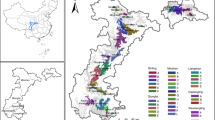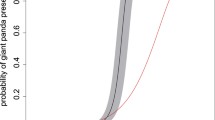Abstract
Even though the giant panda’s extinction status is downgraded from endangered to vulnerable, but the animals still face an uphill battle for survival. Moreover, the number of giant pandas is also rare. With the increase of captive individuals, wild release has become an inevitable task that human face. It is important to evaluate at least how much giant pandas are remained for being released to the wild. Several methods have been presented in the literature to assess minimum viable population (MVP) of giant pandas. However, each of these methods is designed only based on population sizes. In this paper, a membrane computing model based on behavioral biology is proposed to evaluate the MVP of the species. An application of the proposed data processing to binary tree whose nodes are composed of population sizes is also proposed. An binary tree is generated by integrating the following three techniques: (a) a random technique to generate the vast majority of populations; (b) a modified binary search method to obtain an order population size sequence; (c) a modified inorder traversal to generate an order binary tree and a parent tree. This is the first attempt to apply membrane computing model to assess the MVP of giant pandas. The effectiveness of the presented general PDP system is verified by means of the numbers or amounts of subpopulations. Besides, we also provide the population distribution of the obtained MVP.







Similar content being viewed by others
Explore related subjects
Discover the latest articles, news and stories from top researchers in related subjects.References
Adorna HN (2020) Computing with SN P systems with i/o mode. J Membr Comput 2(4):230–245
Buño K, Adorna H (2020) Distributed computation of ak P systems with active membranes for SAT using clause completion. J Membr Comput 2(2):108–120
Ceterchi R, Zhang L, Subramanian KG, Zhang G (2021) Hilbert words as arrays generated with P systems. J Membr Comput 3(3):163–169
Cardona M, Colomer MA, Margalida A et al (2011) A computational modeling for real ecosystems based on P systems. Nat Comput 10(1):39–53
Cardona M, Colomer MA, Pérez-Jiménez MJ et al (2008) A P System modeling an ecosystem related to the bearded vulture. In: Proceedings of the sixth brainstorming week on membrane computing, pp 51–66
Cardona M, Colomer MA, Margalida A et al (2009) AP system based model of an ecosystem of some scavenger birds. In: International workshop on membrane computing, pp 182–195
Ceterchi R, Subramanian KG (2020) Generating pictures in string representation with P systems: The case of space-filling curves. J Membr Comput 2(4):369–379
Colomer MÁ, Margalida A, Sanuy D, Pérez-Jiménez MJ (2011) A bio-inspired computing model as a new tool for modeling ecosystems: the avian scavengers as a case study. Ecol Modell 222(1):33–47
Colomer M, Margalida A, Valencia-Cabrera L et al (2014) Application of a computational model for complex fluvial ecosystems: The population dynamics of zebra mussel Dreissena polymorpha as a case study. Ecol Complexity 20:116–126
Connor T, Qiao M, Scribner K et al (2021) Complex effects of habitat amount and fragmentation on functional connectivity and inbreeding in a giant panda population. Conservation Biology
Dai QL, Li JW, Yang Y, Li M et al (2020) Genetic diversity and prediction analysis of small isolated giant panda populations after release of individuals. Evolut Bioinf 16:1176934320939945
Deng X, Dong J, Wang S, Luo B, Feng H, Zhang G (2022) Reducer lubrication optimization with an optimization spiking neural P system. Inf Sci 604:28–44
Dong J, Zhang G, Luo B, Yang Q et al (2022) A distributed adaptive optimization spiking neural P system for approximately solving combinatorial optimization problems. Inf Sci 596:1–14
Duan Y, Rong0 H, Qi D, Valencia-Cabrera L, Zhang G, Pérez-Jiménez MJ (2020) A review of membrane computing models for complex ecosystems and a case study on a complex giant panda system, Complexity, Volume 2020, Article ID 1312824, 26 pages, https://doi.org/10.1155/2020/1312824
Flather CH, Hayward GD, Beissinger SR (2011) Minimum viable populations: is there a ‘magic number’ for conservation practitioners? Trends Ecol Evolut 26(6):307–316
García-Dorado A (2015) On the consequences of ignoring purging on genetic recommendations for minimum viable population rules. Heredity 115(3):185
Guo J (2007) Wildlife conservation-Giant panda numbers are surging-or are they? Science 316(5827):974–975
Guo J, Chen Y, Zhang H, Chen G, Hu J, Wu YI (2002) A mathematical model for the population of giant pandas and bamboo in Yele nature reserve of Xiangling mountains. J Nat Conserv 10(2):69–74
Hong M, Wei W, Zhou H, Tang J, Han H, Zhang Z (2019) Creative conservation in China: releasing captive giant pandas into the wild. Environ Sci Pollut Res 26(30):31548–31549
Huang Z, Zhang G, Qi D, Rong H (2017) Application of probabilistic membrane systems to model giant panda population data. Comput Syst Appl 26(8):252–256
Jamieson IG, Allendorf FW (2012) How does the 50/500 rule apply to MVPs? Trends Ecol Evolution 27(10):578–584
Jiang H, Hu J (2010) Population viability analysis for the giant panda in Baoxing County, Sichuan. Sichuan J Zool 29(2):160–165
Kang DW, Zhao ZJ, Chen XY, etc. (2020) Characteristics and impacts of solid waste on giant panda habitat in Wanglang nature reserve. Sci Total Environ 724:138–210
Komorowski M, Trzciński T (2019) Random binary search trees for approximate nearest neighbour search in binary spaces. Appl Soft Comput 79:87–93
Lyngdoh MK, Chettri A, Adhikari D, Barik SK (2018) Metapopulation modelling of threatened plants to assess conservation status and determine minimum viable population size. Curr Sci 532–538
Molnár PK, Bitz CM, Holland MM, Kay JE, Penk SR, Amstrup SC (2020) Fasting season length sets temporal limits for global polar bear persistence. Nature Clim Change 10(8):732–738
Nabutanyi P, Wittmann MJ (2021) Modeling minimum viable population size with multiple genetic problems of small populations. bioRxiv. https://doi.org/10.1101/2021.08.02.454753
Orellana-Martín D, Riscos-Núñez A (2020) Seeking computational efficiency boundaries: the Pǎun’s conjecture. J Membr Comput 2(4):323–331
Pérez-Hurtado I, Orellana-Martín D, Zhang G, Pérez-Jiménez MJ (2019) P-Lingua in two steps: flexibility and efficiency. J Membr Comput 1(2):93–102
Qi D, Xu C, Hou R, Chen P, Owens JR, Zhang Z, etc. (2015) Using habitat models to evaluate protected area designing for giant pandas. J Vertebr Biol 64(1):56–64
Ren W, Yang G, Wei F (2002) A simulation model for population viability analysis of giant panda in Mabian Dafengding nature reserve. Acta Theriologica Sinica 22(4):264–269
Shaffer ML (1981) Minimum population sizes for species conservation. BioScience 31(2):131–134
Shi XY, Song GH (2013) A mathematical model with pulse effect for three populations of the giant panda and two kinds of bamboo. Sci World J
Song B, Luo X, Valencia-Cabrera L, Zeng X (2020) The computational power of cell-like P systems with one protein on membrane. J Membr Comput 2(4):332–340
Tian H, Zhang G, Rong H, Pérez-Jiménez MJ (2018) Population model of giant panda ecosystem based on population dynamics P system. J Comput Appl 38(5):1488–1493, 1499
Tong Y (2019) Modeling of giant panda population characteristics based on multi-environment membrane systems. Southwest Jiaotong University, Master thesis
Valencia-Cabrera L, Pérez-Hurtado I, Martínez-del-Amor MÃ (2020) Simulation challenges in membrane computing. J Membr Comput 2(4):392–402
Wu X, Li G, Bi B (2017) A study on population viability analysis and estimation of minimum viable population in triplophysa venusts. Acta Hydrobioogica Sinica 41(3):543–551
Xu HF, Lu JH (1996) Minimum viable population-a basic theory fo conservation biology. Chin J Ecol 15(2):25–30
Xu W, Viña A, Kong L, Pimm, etc. (2017) Reassessing the conservation status of the giant panda using remote sensing. Nat Ecol Evolut 1(11):1635–1638
Yang Z, Gu X, Nie Y (2018) Reintroduction of the giant panda into the wild: a good start suggests a bright future. Biol Conserv 217:181–186
Yi MH (2018) Study on minimum viable population of seed bank in pine forest. Korean J Environ Ecol 32(5):497–506
Zhang D, Yu B, Yu J et al (2015) Scheme design and main result analysis of the fouth national survey on giant pandas. For Resour Manag 1:11–16
Zhang G, Pérez-Jiménez MJ, Gheorghe M (2017) Real-life applications with membrane computing. Springer, Berlin
Zhang G, Pérez-Jiménez MJ, Riscos-Nuñez A et al. (2021) Membrane Computing Models: Implementations, Springer, Berlin July
Zhang G, Shang Z, Verlan S, Martínez-Del-Amor MA et al (2020) An overview of hardware implementation of membrane computing models. ACM Comput Surv 53(4):1–38
Zhang G, Rong H, Paul P, He Y, Neri F, Péez-Jiménez MJ (2021) A complete arithmetic calculator constructed from spiking neural P Systems and its application to information fusion. Int J Neural Syst 31(1):1–17
Zhang G, Zhang X, Rong H, Paul P et al (2022) A layered spiking neural system for classification problems. Int J Neural Syst 2022:32. https://doi.org/10.1142/S012906572250023X
Zhang J, Hu J, Wu H (2002) A analysis on population viability for giant panda in Tangjiahe. Acta Ecologica Sinca 22(7):990–998
Zhang M, Song G (2016) The effect of diffusion loss on the time-varying giant panda population. Int J Biomath 9(04):1650062
Zhu L, Wen W, Zhang H, Hu J (2008) Population viability analysis of giant pandas in the Xiaoxaingling mountains. J China West Norm Univ 29(2):112–116
Zhu LF, Zhang SN, Gu XD, Wei FW (2011) Significant genetic boundaries and spatial dynamics of giant pandas occupying fragmented habitat across Southwest China. Mol Ecol 20:1122–1132
Zhu M, Yang Q, Dong J, Zhang G, et al. (2021) An adaptive optimization spiking neural P system for binary problems. Int J Neural Syst 31(1):1–17. Article No. 2050054. https://doi.org/10.1142/S0129065720500549
Acknowledgements
This work was partially supported by the National Natural Science Foundation of China (61672437 and 61972324) and Sichuan Science and Technology Program (2022YFG0181). We also acknowledge the support of the research project P20_00486 (Junta de Andalucía, Consejería de Economía, Conocimiento, Empresas y Universidad, along with Fondo Europeo de Desarrollo Regional (FEDER) of the European Union).
Author information
Authors and Affiliations
Corresponding author
Additional information
Publisher's Note
Springer Nature remains neutral with regard to jurisdictional claims in published maps and institutional affiliations.
Rights and permissions
About this article
Cite this article
Duan, Y., Rong, H., Zhang, G. et al. Estimation of minimum viable population for giant panda ecosystems with membrane computing models. Nat Comput 22, 69–93 (2023). https://doi.org/10.1007/s11047-022-09901-6
Accepted:
Published:
Issue Date:
DOI: https://doi.org/10.1007/s11047-022-09901-6




